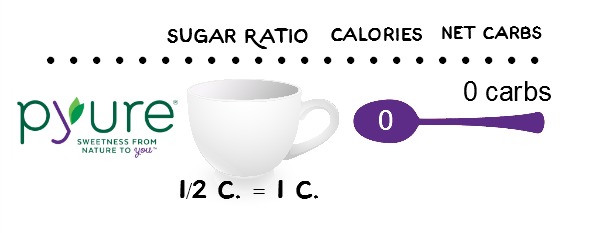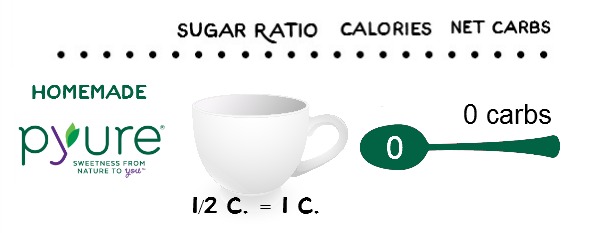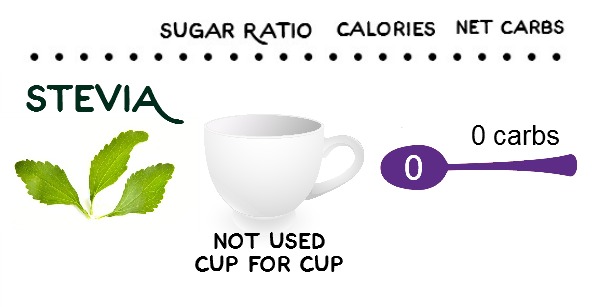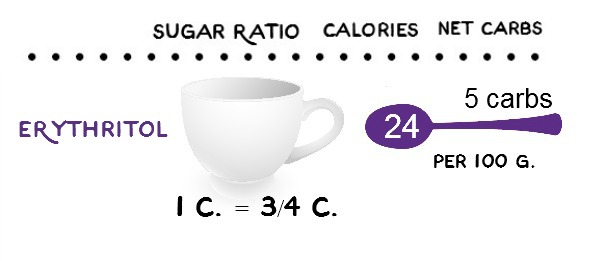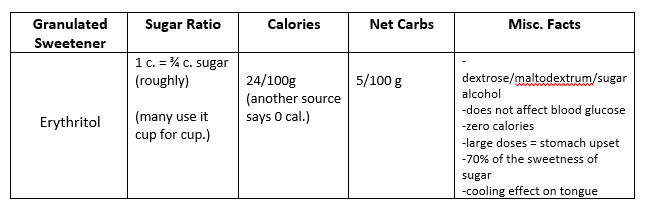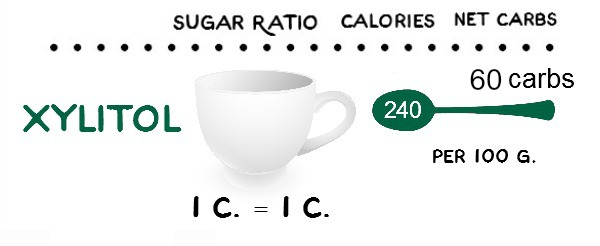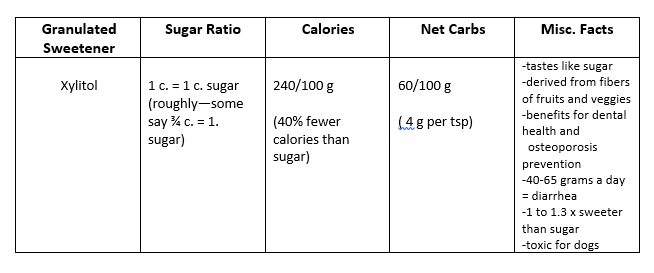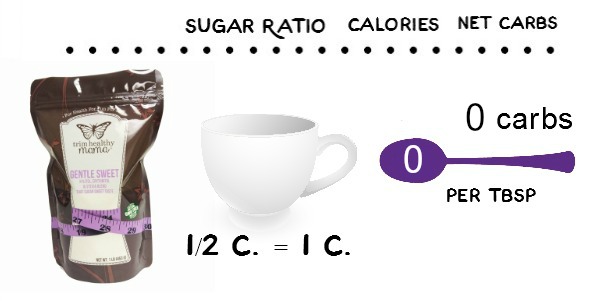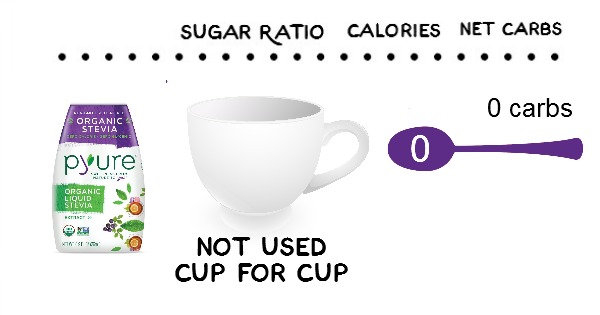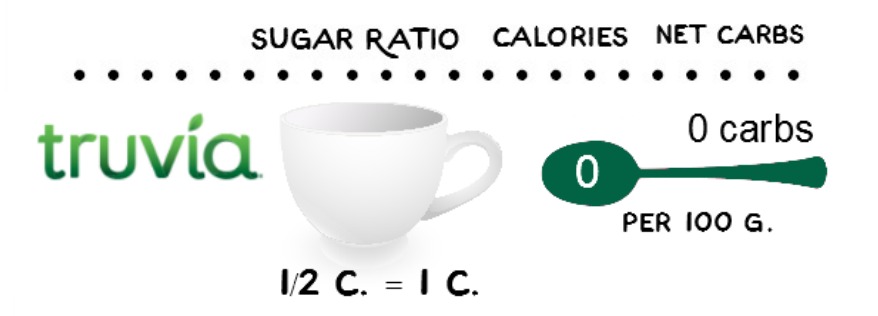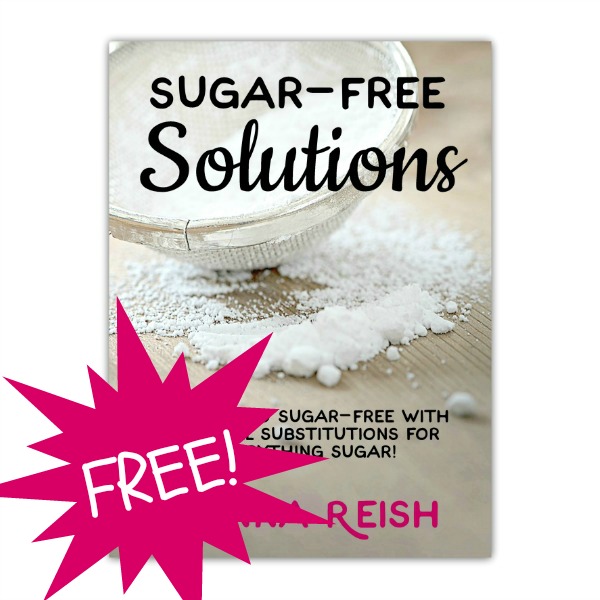Below are the facts and my thoughts on many of the sweeteners from my downloadable Sugar-Free Solutions chart (also available in my FREE ebook, Sugar-Free Solutions)!
Pyure
The Facts About Pyure
Pyure is a combination of stevia extract and erythritol. Both its ingredients are considered natural. They are also both non-nutritive sweeteners and are therefore calorie- and gluten-free. It is 0 on the Glycemic Index, which means it does not affect blood sugar in any way. This mixture is also certified GMO-free by the USDA. The advantage of Pyure over pure stevia is the erythritol. This form of sugar alcohol eliminates some of the excessive sweetness and bitter aftertaste of stevia. This combining also makes it easy on the stomach (compared to others).
Another advantage of Pyure is that it is easy to replace sugar with it. It is also easy to know how much to use; half a cup of Pyure is equal to one cup of sugar. Pyure only comes in granulated form. However, some types have finer grains than others. The confectioners mix is finer, which means it dissolves more easily. In conclusion, Pyure seems to be an upgrade over a number of other sweeteners. Note that Pyure is 0 on the Glycemic Index and does not affect blood sugar.
My Thoughts About Pyure
Pyure has become my favorite after three years of testing. It is available on Amazon (Prime!). It is also available at most Wal-Mart stores. It is one of the most reasonably-priced HEALTHY substitutes. (Yes, sucralose {Splenda} and aspartame {Nutra-Sweet} are cheaper….but they are not natural sweeteners.)
In addition to its availability and price, it is also the least “off tasting” of the ones I have tried. I used to use Swerve (also available at Amazon and other retailers), but it has an annoying cooling effect in the mouth after eating things made with it. Since Pyure is a ½ cup per 1 cup of sugar ratio, less is needed to have the same effect as sugar. This automatically means less off taste. Coupled with the fact that it is a combination of erythritol and stevia, the taste is also less bitter or “different” than just using one sweetener. (See my “Power of Dilution” section.)
The half cup to one cup ratio to sugar means that it is a great sub in baking. Using stevia drops or just a tiny sprinkling of powdered stevia in baking does not give the bulk that is needed for baked goods. (For example, you can’t take a regular cookie recipe and use a teaspoon of stevia in place of two cups of sugar—you need the “bulk” aspect of the sweetener.)
Pyure has worked well in all of the healthy “solutions” in this free Sugar-Free Solutions e-book (honey, maple syrup, corn syrup {“Karo”}, sweetened condensed milk {“Eagle Brand”}, homemade white chocolate, homemade dark chocolate, caramel sauce, chocolate sauce, and more).While erythritol by itself can often have a cooling effect in the mouth, Pyure does not have this quality in the least.
Note: Be sure you are getting the Pyure erythritol and stevia blend and not a sugar-Pyure blend (or a brown sugar-Pyure blend). Those blends have sugar added to them. The label should look like the one below…

Homemade Pyure
The Facts About Homemade Pyure
Pyure is easy to make for yourself too. One cup of erythritol and ½ teaspoon stevia extract are combined to substitute for the granulated Pyure. It is an inexpensive solution for sure. Note that Homemade Pyure is 0 on the Glycemic Index and does not affect blood sugar.
Homemade Pyure
- 1 cup erythritol
- 1/2 tsp. powdered stevia extract
My Thoughts About Homemade Pyure
It is extremely simple to mix up homemade Pyure (or homemade “Truvia” as some call it…thought Truvia is not as natural as Pyure. The homemade version of “Truvia” would be fine and essentially the same.
Obviously one downfall to making your own Pyure is that you would always need to have the two ingredients on hand. I prefer not to use straight up erythritol (have to use it cup-for-cup in place of sugar), so if I don’t have Pyure on hand, and I run out of stevia, I have to resort to using erythritol. On the other hand, it is cost effective to make your own and is easy.
If you want to really dilute the various sweeteners and not have one more strongly than another, you might consider making your own Gentle Sweet (the Trim, Healthy Mama stevia blend). It is used ½ cup for one cup just like Pyure, so it still provides the bulk. Two downsides to making this are that you have to have more ingredients (takes three sweeteners, not two like Homemade Pyure), and it contains xylitol, which is lethal to dogs.
Homemade Gentle Sweet
- 1/2 cup erythritol
- 1/2 cup xylitol
- 1/2 tsp powdered stevia extract
Stevia
The Facts About Stevia
Stevia is an herb that has been used as a sweetener for centuries. The USDA calls it a non-nutritive sweetener, which means it has no calories or nutrients in it. In the past thirty years, people have questioned whether it is really harmless. However, recent studies conducted by the World Health Organization (WHO) concluded that this sweetener is completely safe. Stevia is very sweet (200-300 times sweeter than sugar). So, you do not need to replace sugar with much of it. Using too much will result in a bitter aftertaste.
Stevia comes in a variety of forms. It is sold as a powder and as a liquid. Some people love the powder, but others love the liquid. The downside of the powder is that it is more likely to have artificial sweeteners mixed with it. Both forms are difficult to add without putting in too much. That is a difficulty with stevia, but other than that, it is an excellent natural sweetener option. Note that stevia is 0 on the Glycemic Index and does not affect blood sugar.
My Thoughts About Stevia
Stevia and I were not fast friends. Several years ago, when a group of us would go out to eat, our crunchy friend would make herself some lemonade with a little bottle of liquid that she called “stevia.” She sometimes passed it around, and while the ones without a ten-year-old’s palate could tolerate it, I could not. It was bitter and “yucky.”
Thus, when I began learning to cook and bake low carb and without sugar, stevia was not on my radar. I had already tried it. It wasn’t an option for me. (Stubborn, huh?)
Near the end of 2015, while using straight erythritol, xylitol, and/or Swerve for sweetening my baked goods, I began using Plexus natural health supplements. I was more than a little skeptical as the “pink drink” that is shaken into a bottle of water each day for sugar-cravings, inflammation, fat-blasting, energy, and more had as its sweetener… you guessed it….stevia.
I was pleasantly surprised how similar to a light cherry Kool-Aid Plexus Slim tasted. And I loved it (the taste and its benefits). So I decided to give stevia a try in cooking and baking. And I am so glad that I did.
Stevia is not what it used to be! If you, like me, tried it many years ago and promptly bought some Splenda (aghhh), now is a great time to try stevia again. Pyure is made with a combination of erythritol and stevia. Stevia drops are great in drinks—and even come flavored. Stevia powder can be sprinkled (in ¼ teaspoon increments) into a batter at the end to finish sweetening. It is worth having some on hand even if you use another combination sweetener for bulk baking (like Pyure or Gentle Sweet).
Erythritol
The Facts About Erythritol
Erythritol is a naturally occurring sugar alcohol. Small amounts of it exist in certain fruits, vegetables, and fermented products. It can also be created using glucose fermented with yeast. Though it does have a form of sugar in it, it does not affect blood glucose or calories.
In excessive quantities, erythritol can cause stomach problems. However, per day, the body can safely consume one gram of it per kilogram of body weight. This, of course, is based on the individual. Some do not enjoy erythritol because it has a cooling effect in the mouth after consuming it. Others say that they do not notice this in baked goods—only in drinks and non-baked items.
Erythritol dissolves into other ingredients well. This is definitely an advantage over other sweeteners. It is also about 70% as sweet as sugar. So, the ratio is about 1 cup of erythritol for three-fourths a cup of sugar. There are a variety of products that include this sweetener in them. Swerve is one of the most popular since it tastes very similar to sugar. Erythritol is another wonderful option. Note that erythritol is 0 on the Glycemic Index and does not affect blood sugar.
Thoughts About Erythritol
The first non-sucralose (i.e. Splenda), non-aspartame (i.e. Nutra-Sweet) sweetener I used was Erythritol. I liked that it was a cup-for-cup sugar substitute. That makes recipe conversion easy. I also liked that it could be bought in bulk reasonably.
The popular brand of this that many people use is Swerve. It tastes great. People really like it. However, the cooling effect after eating it was intolerable for me.
Another plus to the Swerve brand, though, is that it comes in granulated and powdered (confectionary). You can literally buy your regular “sugar” and your “powdered” from this company. (See Sugar-Free Substitutions chapter for how to make your own brown “sugar” and powdered “sugar. They are both actually quite simple.)
Xylitol
The Facts About Xylitol
Xylitol is another naturally occurring sugar alcohol. It tastes like sugar, but it has neither the effect on blood sugar nor as many calories as regular sugar. Xylitol is known also for its dental health benefits. Additionally, it means prevent osteoporosis.
Xylitol is about 1 to 1.3 times as sweet as regular sugar. This is obviously an advantage since it can be used to replace sugar at a one-to-one ratio.
Xylitol does have to be used in limited amounts, however. Using more than sixty grams (forty grams for some people) a day will result in diarrhea. Also, you may notice your mouth cooling as a result of consuming xylitol (similar to Swerve). Additionally, Xylitol can be deadly for dogs so that is a downside as well. However, with its health effects and its ability to directly replace sugar, Xylitol is an excellent sweetener choice. Note that xylitol is 13 on the Glycemic Index and does not affect blood sugar.
Thoughts About Xylitol
Xylitol is one of the best-tasting substitutes, in my opinion. However, between its danger to dogs (and it is absolutely lethal if Fido eats a pan of brownies made with it), its stomach issues, and its small number of calories, I choose not to use it very often.
The cup-for-cup substitution appealed to me, especially for bulking in baked goods. It literally acts like sugar. It can be bought in bulk, so it is a less expensive option than some others.
Gentle Sweet
The Facts About Gentle Sweet
Gentle Sweet is a sugar substitute created by Trim Healthy Mama (diet, book, website, company). It is designed to have a taste that is as close to sugar as possible. To accomplish this, it combines stevia, erythritol, and xylitol.
Gentle Sweet does not have the same sweetness as sugar, however. It is about twice as sweet as sugar. Therefore, you only need about half a cup of it for every one cup of sugar.
Because it is a combination of several sweeteners, Gentle Sweet neutralizes some of the downsides of each individual ingredient. It does not have as much of the bitter aftertaste of stevia. It also does not cause digestion problems like xylitol. Additionally, it does not have the same cooling affect as erythritol. Some people still say that it has some of these effects. However, overall, Gentle Sweet seems like a wonderful sugar substitute option. Note that Gentle Sweet is 0 on the Glycemic Index and does not affect blood sugar.
Thoughts About Gentle Sweet
I personally have not used Gentle Sweet. I love the idea that it combines all three sweeteners—as the dilution effect would come into play. (See earlier in this book.) I also like that, similar to Pyure, it can be used in a ½ to 1 cup ratio to sugar in recipe conversions. It is a great option when bulk is needed in baked goods.
It is a little pricey compared to Pyure, and when you add in the shipping (compared to picking up Pyure at Walmart or on Amazon Prime), this can be a significant price difference. There are some calories in it because of the xylitol—about five per teaspoon (compared to thirty-two per two teaspoons (comparable to one teaspoon of Gentle Sweet) for sugar). Because xylitol and erythritol are sugar alcohols, the carb count is neglible. (Sugar alcohols are non-absorbable carbs, sort of like subtracting fiber from your carb count.) Beware also that even a small amount of xylitol can be harmful to dogs.
Liquid Pyure
The Facts About Liquid Pyure
Liquid Pyure, also called Pyure Organic Stevia Liquid Drops, is a “baby sister” product to granulated Pyure. It is USDA Organic Certified, non-GMO, and alcohol free. It also contains no calories or gluten. Note that Liquid Pyure is 0 on the Glycemic Index.
Thoughts About Liquid Pyure
I don’t go anywhere without my bottle of liquid Pyure drops! At home, I make lemonade, limeade, or a combination all the time using a little real lemon or lime juice (bottled works well also) and a couple of drops of Pyure. It is the perfect sweetener for smoothies, punches, shakes, and more.
The liquid is also great for when you are making something and it is all mixed but still needs a touch of sweetener. A couple of drops will add just the amount you need without re-mixing a lot of bulk sweetener in. (I recommend this when making desserts with my Cream Cheese Dessert Base from the Healthy Mixes book of that same name—coming in the first quarter of 2017 {though some of the recipes are at the blog already}.)
Truvia
The Facts About Truvia
Truvia is a mixture of rebaudioside A, erythritol, and natural flavors. Rebaudioside A is a processed form of stevia. It is created by steeping stevia leaves and purifying the resulting liquid. It has also been suggested the Truvia can only even say that it contains stevia because it has less than one percent of the rebaudioside.
Also, the erythritol used in Truvia is not as natural. Erythritol naturally occurs in fruits, but Truvia uses a form created by processing corn. The corn is turned into a starch and then fermented to create glucose. It is then processed further to create erythritol.
It would seem that Truvia is not as natural as a result of these ingredients. It is also unknown whether the corn is GMO or not.
However, Truvia is one of the most popular sugar substitutes. It is also easy to use to replace sugar. One packet of Truvia is equal to about two teaspoons of sugar. Similar to Pyure and Gentle Sweet, Truvia is a ½ to 1 cup substitution for sugar. Therefore, it is easy to use in baked goods. Combining all these facts together, Truvia is a popular sweetener, but not a natural one.
My Thoughts About Truvia
Truvia is super convenient and easy to buy/find. It is even available as a packet option in many restaurants. The taste must be acceptable for it to make it into mainstream sweetening so easily. However, if you are trying to go sugar-free for health reasons, it is probably not the best choice due to its questionable processing and ingredients.
Click here to pin an infographic that shows each of these sweeteners and their sugar ratio!

![Healthy Sugar-Free Substitutes [FREE eBook Chapter] Healthy Sugar-Free Substitutes [FREE eBook Chapter]](https://farm6.staticflickr.com/5457/31182254411_ff43db3de5_z.jpg)
